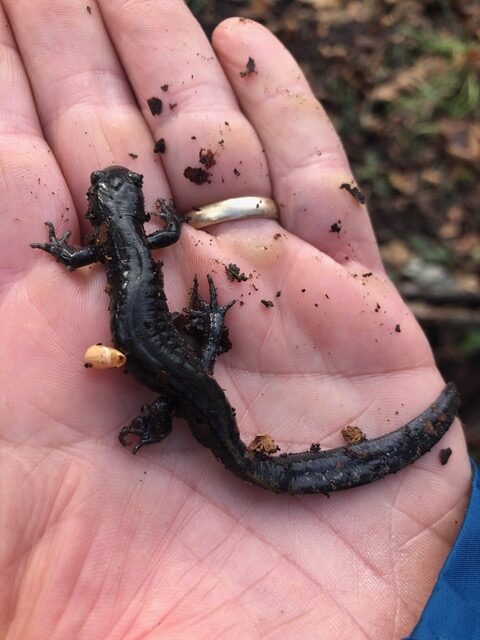Published in Seattle Times: https://www.seattletimes.com/opinion/springtime-is-for-salamanders-and-journeys-of-discovery/
Warming spring days cause many Northwesterners to reach for binoculars and look up for birds. My inclination is to look down. It’s time to find salamanders, encounters that could lead you to adventures, a career, and your tribe.
Sure – bird watching is popular. That’s because it’s easy. Birds flit, they fly, they hop, they sing. Birds are colorful and visible reminders that the long winter is past. Hidden by their size and habits, salamanders – those charismatic micro-fauna, integral to ecological functions, are equally worthy of consideration. An early fascination with salamanders propelled me to a career as a wildlife ecologist where I’ve studied throughout the U.S. west coast and from the Northern Mariana Islands to Madagascar.
A morning at Boy Scout camp in the forests of northern New Jersey is embedded in my memory, fixed like a bone in the tar pits. As if opening a magical hatch, I lifted a large rock and was stunned. Looking up at me was a dark, fat-bodied salamander, 8 inches long with yellow spots as bright as minute suns. A spotted salamander, one of the aptly named mole salamanders that live most of their life underground, emerging briefly in spring to breed in ephemeral ponds. Shocked at its size I froze, watching it scurry into a crevice.
Here in the Pacific Northwest spring, tiger salamanders emerge from their fossorial homes to breed, and the poisonous rough-skinned newt accelerates its activities with the warming sun (poisonous – you bite it, you’re harmed; venomous – it bites you, you’re harmed).
Long-toed salamanders, a gold stripe extending along their back, with their namesake extended rear digit, are often the first salamanders to reach ponds where I’ve watched them breed under a thin layer of ice. I’ve found northwestern salamander egg clusters in ponds at the Seattle Arboretum. They are all around us.
A fellow ecologist and I were conducting a survey and upon finding a red-back salamander, Brian went into a soliloquy. In the family Pelethodontidae – these lungless salamanders absorb oxygen through their skin, seek moist habits, and lay their eggs in damp soil.
Brian recalled one study where their forest biomass surpassed that of all birds during the breeding season. Considering that an equally large number of these salamanders were further below ground and out of reach, the estimate of 3 million individuals per acre is likely low. These are the most abundant animals in the leaf litter and significantly contribute to ecosystem function, particularly in complex leaf-litter food webs.
“That’s just pretty crazy when you think about”, said Brian. “All those little guys just crawling around in the dark beneath our feet.”
He paused and nudged one with his finger “Pretty little things too” he said, then carefully laid back the rock that hid the salamander. Brain was one of my close friends and colleagues, my found science tribe.
Brain passed away a few years ago in a tragic accident. To honor him and my early salamander encounter, I received my first tattoo at age 66. It’s a precise drawing of a spotted salamander, a reminder of what carried me forward from childhood through my career – and still does, a passion for salamanders.
I now bear a visual reminder of one creature that sparked my wonder of the natural world, and of those people I cherish because of their inquisitiveness, their science knowledge, integrity, and their friendship. Like the ink I now display, that will never fade away.
It’s worth a look down, under a rock, or along a pond edge. You never know where it will lead.

Love Love Love Salamanders. Have not gone looking for them for years. This article has inspired me to turn over a few rocks on my next walk somewhere moist. Also wondering if our rain garden may be harboring any, except all the rocks were removed (except inflow and outflow–the latter of which never has, but may be moist enough? … worth exploring.
Outside of Seattle Parks, I’ve not found salamanders in the city. Maybe if you have a green belt adjacent to you there would be more of a chance. There is some minimal size habitat parcel that is needed – depends on species. A good place to look to see what and where people are finding things is iNaturalist. Can explore map on a laptop and there is a free phone app. Happy hunting.